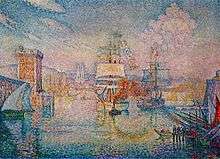Musée Cantini
The Musée Cantini is a museum in Marseilles that has been open to the public since 1936. The museum specializes in modern art, especially paintings from the first half of the twentieth century.
%2C_oil_on_canvas%2C_54_x_65_cm%2C_Mus%C3%A9e_Cantini%2C_Marseille.jpg)

The building
The musée Cantini building was built in 1694 for the Compagnie du Cap Nègre. The company ran into financial difficulties and the building was sold in 1709 [1] to Dominique de Montgrand great-grandfather of Jean-Baptiste-Jacques-Guy-Thérèse de Montgrand, future Mayor of Marseille.[2] The building was then sold to Louis Joseph Chaudoin in 1801 and to Dieudonné Bernadac in 1816. In 1888, it was acquired by Jules Cantini who bequeathed it to the City of Marseille in 1916, with the stipulation that it was to become a museum of decorative arts. The museum was opened in 1936.
The Collection
The Musée Cantini has one of the largest public collections in France of the 1900-1960 period. A wide variety of artists is represented, including Charles Camoin, Raoul Dufy, Albert Gleizes, Henri Laurens, Wassily Kandinsky, František Kupka, Jean Hélion, Alberto Magnelli, Amédée Ozenfant, Max Ernst, André Masson, Simon Simon-Auguste, Victor Brauner, Joan Miró, Jean Arp.
Pointillisme, fauvisme et cubisme
- Paul Signac, La Corne d'or, Matin, 1907 et Entrée du Port de Marseille, 1918
- André Derain, Pinède, Cassis, 1907
- Raoul Dufy, Landscapes of l'Estaque, 1908
- Albert Gleizes, L'Ecolier and Etude pour Femme assise, c.1920
- Emile Othon Friesz, Auguste Chabaud, Charles Camoin, Alfred Lombard
Inter-War Period
- Oskar Kokoschka, Le port de Marseille, 1925
- Jean Hélion, Composition verticale, 1936
- Alberto Magnelli, Pierres n°2, 1932
- Jeanne-Laure Garcin, Les Hommes et la machine, 1932
- Julio Gonzalez, Danseuse à la palette, vers 1934
- Wassily Kandinsky, František Kupka, Jacques Villon ...
Surrealism
- Max Ernst, Monument aux oiseaux, 1927
- Jacques Hérold, Les Têtes, 1939
- André Masson, Antille, 1943, Le Terrier, 1946
- Jean Arp, Genèse, 1944
- Joseph Cornell, Flat sand box, vers 1950
- Roberto Matta, Contra vosotros asesinos de palomas, 1950
- Wifredo Lam, Francis Picabia, Victor Brauner ...
From World War II to 1980
- Pablo Picasso, Tête de femme souriante, 1943;
- Fernand Léger, Nature morte au couteau, 1945;
- Nicolas de Staël, Harmonie rouge, bleue et noire, 1951;
- Alberto Giacometti, Portrait de Diego, 1957;
- Roland Bierge, Nature morte à la Théière brune, 1957;
- Balthus, Nature morte à la lampe, 1958, Le Baigneur, 1960;
- Jean Dubuffet,Vénus du trottoir, 1946, Brouette en surplomb I, 1964;
- Francis Bacon, Autoportrait, 1976;
- Antonin Artaud, Vieira da Silva...
- Jean-Charles Blais, s.t, huile sur bois et collage, 1986;
Drawings
The museum has drawings by André Derain, Pierre Bonnard, André Masson, Francis Picabia, Mark Rothko, Pablo Picasso, Edward Hopper, Victor Brauner, Jean Dubuffet...
Degas theft
In 2009 the museum was exhibiting Edgar Degas's pastel on monotype Les Choristes, on loan from the Musée d'Orsay in Paris. It was stolen at the end of the year; the investigation went cold until 2018, when customs officers recovered it from the luggage compartment of a bus outside Paris.[3]
Bibliography
- Régis Bertrand, Lucien Tirone, Le guide de Marseille, édition la manufacture, Besançon, 1991, ISBN 2-7377-0276-3
References
- Gaston Rambert, Histoire du commerce de Marseille, Plon, Paris, 1954, 7 volumes, tome 4 page 235
- Comte Godefroy de Montgrand, Armorial de la ville de Marseille, Alexandre Gueidon, Marseille, 1864, page 274-275
- Breeden, Aurelien (February 23, 2018). "Degas Painting, Stolen in 2009, Is Found on Bus Near Paris". The New York Times. Retrieved January 24, 2019.